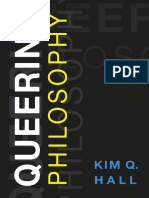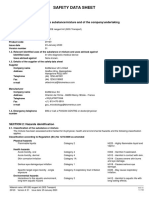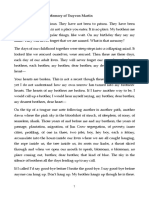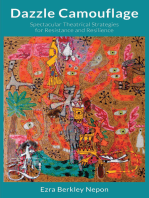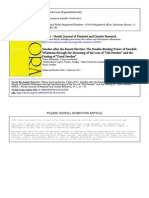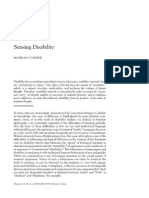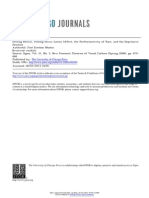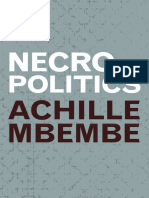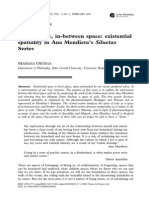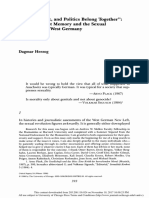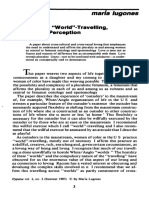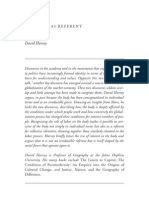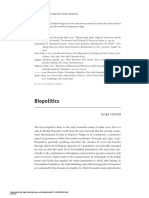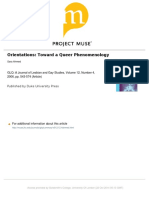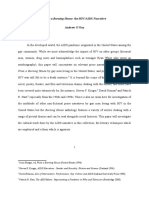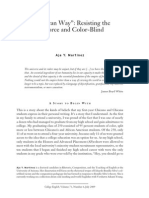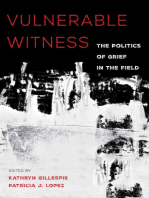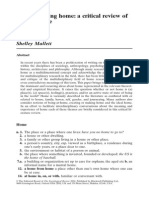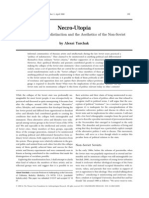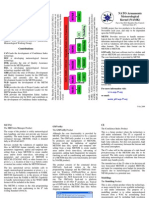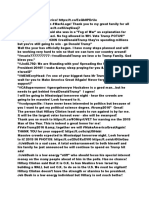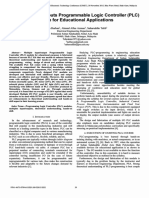Iyko Day - Being or Nothingness
Iyko Day - Being or Nothingness
Uploaded by
Kat BrilliantesCopyright:
Available Formats
Iyko Day - Being or Nothingness
Iyko Day - Being or Nothingness
Uploaded by
Kat BrilliantesOriginal Title
Copyright
Available Formats
Share this document
Did you find this document useful?
Is this content inappropriate?
Copyright:
Available Formats
Iyko Day - Being or Nothingness
Iyko Day - Being or Nothingness
Uploaded by
Kat BrilliantesCopyright:
Available Formats
Being or Nothingness: Indigeneity, Antiblackness, and Settler Colonial Critique
Author(s): Iyko Day
Source: Critical Ethnic Studies , Vol. 1, No. 2 (Fall 2015), pp. 102-121
Published by: University of Minnesota Press
Stable URL: https://www.jstor.org/stable/10.5749/jcritethnstud.1.2.0102
REFERENCES
Linked references are available on JSTOR for this article:
https://www.jstor.org/stable/10.5749/jcritethnstud.1.2.0102?seq=1&cid=pdf-
reference#references_tab_contents
You may need to log in to JSTOR to access the linked references.
JSTOR is a not-for-profit service that helps scholars, researchers, and students discover, use, and build upon a wide
range of content in a trusted digital archive. We use information technology and tools to increase productivity and
facilitate new forms of scholarship. For more information about JSTOR, please contact support@jstor.org.
Your use of the JSTOR archive indicates your acceptance of the Terms & Conditions of Use, available at
https://about.jstor.org/terms
University of Minnesota Press is collaborating with JSTOR to digitize, preserve and extend access
to Critical Ethnic Studies
This content downloaded from
137.165.4.112 on Sat, 24 Oct 2020 16:51:52 UTC
All use subject to https://about.jstor.org/terms
Being or Nothingness
Indigeneity, Antiblackness, and Settler Colonial Critique
I Y KO D AY
T his special issue’s focus on comparative racial scholarship gives me an
opportunity to weigh in on the specific interplay of race and settler col0
nialism within an expanding sphere of American studies, one that intersects
with and broadens the long-standing critical terrain of Indigenous studies
in North America. I am particularly interested in exploring the connection
between settler colonial studies and black studies, especially in relation to
binary formulations of colonial and racial formation. This is expressed either
as an Indigenous/settler binary constituted in relation to land or a black/
nonblack binary founded on racial slavery. These approaches are at times
deeply skeptical of relational or comparative analyses of race and reject any
coalitional premise that unifies people of color generally. On this count,
Jared Sexton argues that a form of “people-of-color-blindness” is embedded
in the relational concept of “people of color,” one that fundamentally mis-
understands “the specificity of antiblackness and presumes or insists upon
the monolithic character of victimization under white supremacy.”1 Acknowl-
edging these points, I focus on the exceptionalism produced by these binary
frameworks, whereby both the Native and the black body signify a genocidal
limit concept. For instance, Patrick Wolfe casts settler colonialism as a zero-
sum game that requires “the elimination of Native alternatives” and results
in the “social death of Nativeness.”2 Alternatively, writing from the perspec-
tive of Afro-pessimism, Frank B. Wilderson III writes, “from the very begin
ning, we [black people] were meant to be accumulated and die.”3 Extending
an Afro-pessimist critique to the field of settler colonial American studies,
moreover, Sexton argues that settler colonial decolonization movements for
Indigenous sovereignty embrace a Negrophobic discourse of “post-racialism
by diminishing or denying the significance of race in thinking about the
relative structural positions of black and non-black populations.”4 To be
clear, my intentions in this article are not to engage in an evaluation of who
P 102 O
This content downloaded from
137.165.4.112 on Sat, 24 Oct 2020 16:51:52 UTC
All use subject to https://about.jstor.org/terms
P Being or Nothingness • 103 O
the greater victim is—even if this kind of evaluation is precisely the objec-
tive of the scholarship under discussion. Rather, it is to probe the discursive
construction of colonial and racial exceptionalism itself, particularly in
terms of their relation to a privileged conception of labor within Karl Marx’s
theory of primitive accumulation. For it is within these chapters of Capital,
Volume I that Marx connects enslavement and colonial genocide under a
broader logic of capitalist accumulation through the violent expropriation
of land and labor. Guiding this inquiry is a larger motivating question about
whether settler colonial critique has an immanent capacity to examine race.
Before I proceed, I want to acknowledge that the intersection of Indige-
neity and antiblackness in the continental United States presents a unique
set of issues, insofar as Occupied Palestine and Hawai‘i have emerged as
equally if not more prominent than the continental United States as sites
for theorizing the eliminatory logics of settler colonialism.5 Part of this cen-
trifugal dynamic may be attributed to the fact that unlike other white settler
colonies like Canada, where colonial dispossession is the paradigmatic signi
fier of white settler supremacy, in the continental United States it has been
the legacy of slavery and antiblack racism. This is certainly not to say that
the ongoing dispossession of Indigenous peoples in the United States goes
completely unacknowledged but rather to appreciate the fact that alongside
recent Indigenous sovereignty movements such as Idle No More in Canada
or the BDS movement in Occupied Palestine, it has been Ferguson in the
United States. Thus, the centrifugal or long-distance lens that I associate
with settler colonial American studies is clearly a reflection of the contin-
ued tensions around theorizing the intersection of race and Indigeneity.
Together with what Saidiya Hartman calls the “afterlife of slavery,” the logic
of antiblackness complicates a settler colonial binary framed around a cen-
tral Indigenous/settler opposition.6 Understandably, there is conceptual dif-
ficulty in folding the experience of racial capture and enslavement into the
subject position of the “settler.”
But if we move outside the continental United States, questions raised
by such binaries dissipate in the face of the starkest and most brutal binary
colonial formations. Occupied Palestine, a comparatively recent site of set-
tler colonialism, is such a place, powerfully magnifying the struggle between
settler and Indigenous populations in ways that recall the frontier violence
of nineteenth-century America. The illegal occupation, siege of Gaza, and
ongoing construction of residential settlements on the West Bank is an
uncanny corollary to the lead up to the 1830 Indian Removal Act, which
relocated tens of thousands of peoples from the Southeastern Nations east
This content downloaded from
137.165.4.112 on Sat, 24 Oct 2020 16:51:52 UTC
All use subject to https://about.jstor.org/terms
P 104 • IYKO DAY O
of the Mississippi River. From this view, the glaring binarism of Occupied
Palestine offers a window onto U.S. history. But it is for the same reason that
Bill V. Mullen’s description of Occupied Palestine as “the most dialectical
place on Earth” is unable to capture the racial heterogeneity of the conti-
nental United States in the present tense.7 Further, in the case of Hawai‘i,
another relatively recent site of settler colonialism, Asian Americans have
replaced original white settlers and transformed and extended those elimi-
natory logics into a formation of Asian settler colonialism that is also reflec-
tive of the Indigenous/settler binary.8 As Dean Saranillio explains, “While
migration in and of itself does not equate to colonialism, migration to a
settler colonial space, where Native lands and resources are under political,
ecological, and spiritual contestation, means the political agency of immi-
grant communities can bolster a colonial system initiated by White set-
tlers.”9 The lesson that Hawai‘i offers is one in which a formerly exploited
migrant population has achieved structural dominance. Although white set
tlers exploited indentured Asian laborers in the 1890s as part of the process
of dispossessing Native Hawaiians of their land, Asian American invocations
of “local” identity and rejection of Native Hawaiian claims for sovereignty
reproduce the logics of colonial dispossession. Here Patrick Wolfe’s clarifica
tion that settler colonialism is a “structure not an event” is especially salient.10
In comparison to Canada or Australia, what I would describe as a certain
attenuation in identifying the continental United States as a settler colony
may also be attributed to an ideology of American exceptionalism and his-
tory of empire building, which are possibly the most exemplary expressions
of settler colonialism. Indeed, what distinguishes the United States as a set-
tler colony is the way it epitomizes a paradigm of endless invasion of both
Indigenous and foreign lands.11 Unlike former franchise colonies, such as
British India or the Dutch East Indies—regions where economic exploi
tation occurred without large-scale white settlement—settler colonies are
also largely immune to decolonization because settlers don’t leave. They are
“breakaway” colonies insofar as they transfer the power of the metropolitan
center to the periphery, subverting a normative logic of colonialism.12 In
establishing British settler colonies, it was specifically land acquisition that
was the primary objective rather than the exploitation of Indigenous labor.13
Because white settlement was a primary goal in British North America,
Australia, New Zealand, and South Africa, the process of detaching from
British imperial rule—becoming “postcolonial” as it were—did not struc-
turally alter the colonial relationship between settlers and Indigenous pop-
ulations. In other words, there is no “post” to settler colonialism. As Werner
This content downloaded from
ffff:ffff:ffff:ffff:ffff:ffff:ffff on Thu, 01 Jan 1976 12:34:56 UTC
All use subject to https://about.jstor.org/terms
P Being or Nothingness • 105 O
Biermann and Reinhart Kössler reflect on the irony of revolutionary settler
independence movements like those in the United States, “settler counter-
imperialism cannot, in any sense, be considered of an emancipatory nature,
but rather as a defense for atavistic forms of exploitation which by this token
take on a politically anachronistic stature as well.”14 Therefore, in settler
colonies, the diminishing role of an imperial metropole actually facilitated
successive stages of Indigenous elimination that involved invasion, removal,
relocation, reservation, termination, and assimilation. This renders a para-
doxical situation where, as Robert J. C. Young describes it, “the postcolonial
operates simultaneously as the colonial.”15
THE TWO STATES OF SETTLER COLONIALISM
In a nation with such fraught contexts of forced migration, immigrant ex-
clusion, relocation, and deportation, questions inevitably arise over whether
non-Indigenous but racialized peoples—such as slaves, refugees, or the
undocumented—are unequivocally “settlers.” The responses to this ques-
tion have been varied. On the one hand, Lorenzo Veracini has distinguished
migrants from settlers, claiming that “migrants, by definition, move to
another country and lead diasporic lives, settlers on the contrary, move . . .
to their country.”16 The crucial distinction that Veracini draws turns on the
question of sovereignty: settlers bring their sovereignty with them, and
migrants do not. Jodi A. Byrd extends this kind of distinction by offering
the term arrivant to “signify those people forced into the Americas through
the violence of European and Anglo-American colonialism and imperialism
around the globe.”17 Patrick Wolfe, on the other hand, registers unwavering
opposition to any view that suggests that a lack of embodied sovereignty—or
any other condition of migration—has any bearing on what he casts as an
inexorable logic “whereby settler societies, for all their internal complexities,
uniformly require the elimination of Native alternatives.”18 He further charges
that any “post-structuralist indictment of binarism endorses colonial policy-
making” because it implies that the “originary binarism has become dis-
solved or transcended.”19 Below I look more closely at Wolfe’s argument and
its implications for framing race and Indigeneity before turning to Afro-
pessimist arguments regarding an essential black/nonblack binary.
Taking each of Wolfe’s points in turn, my primary objective is to show
how he both evacuates race and projects voluntarism into his characteri-
zation of the settler. Directing his comments primarily at U.S. academics,
Wolfe’s argument rests on two main points that (1) reject the relevance of
This content downloaded from
137.165.4.112 on Sat, 24 Oct 2020 16:51:52 UTC
All use subject to https://about.jstor.org/terms
P 106 • IYKO DAY O
migrant voluntarism as a constitutive feature of the settler and (2) decouple
race from settler colonialism.20 First, he argues that it is a mistake to define
the settler according to a criterion of voluntarism because the opposition
between the Native and the settler is “a structural relationship rather than
an effect of the will.”21 This framework applies to enslaved people too:
The fact that enslaved people immigrated against their will—to cite the
most compelling case for voluntarism—does not alter the structural fact
that their presence, however involuntary, was part of the process of Native
dispossession. White convicts [in Australia] also came against their will.
Does this mean their descendants are not settlers?22
While his claim that being a settler is “not an effect of the will” has merit,
he implicitly preserves the voluntarism that he otherwise rejects in his
construction of the slave. In particular, he draws on the Australian context
in which white convict labor was imported from Britain in order to pose
the rhetorical question: “does this mean their descendants are not settlers?”
Given that Wolfe concedes that white convicts in Australia did not pass the
condition of their criminal enslavement onto their offspring, it is surpris-
ing that he presents it as a comparative equivalent to a U.S. history of Afri-
can slavery. The very content of black racialization has been based on the
exclusive and transferable condition of racial enslavement. Furthermore,
his repeated usage of “immigrants” projects into every migrant a set of vol-
untaristic assumptions and functions as a problematic stand-in for widely
divergent conditions of voluntary and forced migration that are central fea-
tures of the United States’ specific configuration as a settler colony. Former
slaves, war refugees, and undocumented migrants are no more “immigrants”
than Indigenous peoples. More pointedly, from the standpoint of Afro-
pessimism, Jared Sexton states, “No amount of tortured logic could permit
the analogy to be drawn between a former slave population and an immi-
grant population, no matter how low-flung the latter group.”23 Wolfe’s blan-
ket usage of “immigration” also papers over a long history of racialized
immigrant restriction, which barred or restricted the flow of Asian migrants
from the late nineteenth century until 1965. And for those Asian migrants
who remained “aliens ineligible for citizenship” until the mid-twentieth
century or the Japanese civilians who were relocated as “enemy aliens” dur-
ing World War II, immigrant status was inordinately conditioned by race. In
the contemporary context, racialized vulnerability to deportation of undoc-
umented, guest-worker, or other provisional migrant populations similarly
This content downloaded from
137.165.4.112 on Sat, 24 Oct 2020 16:51:52 UTC
All use subject to https://about.jstor.org/terms
P Being or Nothingness • 107 O
exceed the conceptual boundaries that attend “the immigrant.” The fact
that I am pointing this out doesn’t absolve any of these groups from being
willing or unwitting participants in a settler colonial structure that is driven
to eliminate Indigenous people. However, folding them into a generalized
settler position through voluntaristic assumptions constrains our ability to
understand how their racialized vulnerability and disposability supports a
settler colonial project.
Wolfe’s second point is to argue that settler supremacy and white suprem-
acy, while often being “privileges that are fused and mutually compound-
ing in social life,”24 are actually categorically distinct modalities of power.
He turns to the examples of colonized Tibetans, West Papuans, Khoi-san,
Kashmiris and others to demonstrate that the terms of their colonial dis-
possession have nothing to do with race. He writes, “Campaigning against
White supremacism would not help these people. It would be more likely
to delight their colonisers.”25 In sum, one’s status as a settler is neither an
effect of the will nor a condition of one’s racial supremacy. Being a settler is
solely constituted by being structurally opposed to Indigenous peoples. Here,
Wolfe misses the point while overstating his case. While white supremacy
may not be a feature of the colonial dispossession of Tibetans, doesn’t a
Chinese supremacy exercise racial dominance over Tibetans? The example
of the Khoisan is even more peculiar. It is not clear how this Indigenous
population in South Africa is not shaped by the vestiges of apartheid and
enduring structures of white supremacy given that their land and water
were dispossessed by European settlers in what is now Cape Town.26 More-
over, in Wolfe’s assertion that “the primary motive [of settler colonialism] is
not race . . . but access to territory,” such a claim effectively evacuates the
proprietorial nature of whiteness, one that led W. E. B. Du Bois to define
“Whiteness [as] the ownership of the earth forever and ever, Amen.”27 Racial
supremacy shifts over time and space—as do constructions of whiteness.
Nevertheless, I propose that racial dynamics are internal rather than exter-
nal to the logic of settler colonialism in North America.
AFRO-PESSIMISM AND THE TOTALITY
The paradigm of Afro-pessimism offers an interesting corollary to the
Indigenous/settler binary discussed above. My discussion of this critical
theory rests on the terms of its binary formulation and rejection of Indige-
nous sovereignty that have been advanced by Jared Sexton and Frank
Wilderson, perhaps the most vocal proponents of this school of thought.28
This content downloaded from
137.165.4.112 on Sat, 24 Oct 2020 16:51:52 UTC
All use subject to https://about.jstor.org/terms
P 108 • IYKO DAY O
My goal here is to respond to their critique of Indigenous sovereignty by
reframing the relation between colonialism and racial slavery and to chal-
lenge the antidialectical stance of Afro-pessimist critique. Although Afro-
pessimism rejects Marxian political economic analysis,29 it operationalizes
a revised paradigm of economic determinism to install instead an antiblack
base that generates a global racial superstructure.
Rather than reinscribe a black/white opposition, Afro-pessimism charts
a black/nonblack binary that evolves out of the history of racial slavery. The
reason for absorbing whiteness into a variable condition of nonblackness
is to deemphasize white power and instead emphasize the singularity and
paradigmatic status of racial blackness as the essential condition of enslave-
ability. According to Sexton, white people are better termed “all nonblacks . . .
because it is a racial blackness as a necessary condition for enslavement that
matters most, rather than whiteness as a sufficient condition for freedom.”30
In what Sexton terms an “unequally arrayed category of nonblackness,”
Wilderson designates white subjects as the “senior partners” and other non-
white, nonblack racialized subjects as the “junior partners of civil society.”31
The indelible, iterative structure of racial slavery is what animates our con-
temporary moment—what Sexton refers to as a future anterior—a mathe-
matical terror that Saidiya Hartman grounds in the “racial calculus and
a political arithmetic that were entrenched centuries ago.”32 Rejecting the
Indigenous/settler opposition put forward by Wolfe, Sexton states that the
U.S.-born slave-descended population “suffers the status of being neither
the native nor the foreigner, neither the colonizer nor the colonized.”33 Thus
blackness is both a lived impossibility and categorical exception. Wilderson
further contends that black life is an evacuated historical category, a lived
entity that is “off the record.”34 Unlike Native Americans, whom he claims
have recourse to historical modes of ontological embodiment—such that
they exist “liminally as half-death and half-life between the Slave (black)
and the Human (White or nonblack)”—black people are a categorical nega-
tion, part of “America’s structuring irrationality” that engenders the coher-
ence and rationality of white life.35
Wilderson and Sexton extend these arguments about the relationality of
black and Indigenous ontologies of non- or half-life respectively to further
interrogate the validity of Indigenous sovereignty movements. These argu-
ments are taken from Wilderson’s articles and 2010 monograph Red, White &
Black: Cinema and the Structure of U.S. Antagonisms, which are expanded
upon in Sexton’s 2014 article, “The Vel of Slavery: Tracking the Figure of the
Unsovereign.” To begin then with Wilderson’s formulation, for him Indige-
neity differs from antiblackness because Indigenous sovereignty struggles
This content downloaded from
137.165.4.112 on Sat, 24 Oct 2020 16:51:52 UTC
All use subject to https://about.jstor.org/terms
P Being or Nothingness • 109 O
engage in a politics of state recognition that is categorically unavailable to
black subjects. More than this, Wilderson claims that Native sovereignty
claims ultimately uphold rather than undermine white supremacy and the
coherence of the U.S. nation-state. He writes, “White supremacy has made
good use of the Indian subject’s positionality: a positionality which fortifies
and extends the interlocutory life of America as a coherent (albeit geno-
cidal) idea, because treaties are forms of articulation, and discussions bro-
kered between two groups presumed to possess the same kind of historical
currency: sovereignty.”36 In their critical alliance, Wilderson and Sexton
emphasize how “the dynamics of Negrophobia are animated . . . by a pre
occupation with sovereignty.”37
The claim of Negrophobic Indigenous sovereignty is rooted in Wilderson’s
somewhat selective reading of Chris Eyre’s 2002 feature film Skins about
Native American vigilantism and alcoholism. Here he argues that the Native
American protagonist Rudy Yellow Lodge’s preoccupation with spiritual-
ity and sovereignty animates his Negrophobia. Wilderson’s rationale for this
interpretation is that Rudy has the capacity to be aligned with a politics of
genocide rather than sovereignty, the latter of which forecloses a shared
antagonism with black existence. Such an emphasis on sovereignty there-
fore represents a “de-escalation of antagonism to the level of conflict.”38 In
particular, Wilderson links Rudy’s investment in sovereignty to his anger at
two Native teens for “acting ‘Black’ . . . their grunting voices and aggressive
body language [indicating] that they are talking ‘Black.’”39 Because the teens
get into a fight with one another, Wilderson registers Rudy’s “sovereign” re-
jection of the corrosive effects of blackness. The teens’ mimicry of blackness
is presented as the cause of their fight: “Rap lyrics, dialect, and Black male
body language have pulled these two young men into a pit of absolute dere
liction and cultural abandonment,” which leads Wilderson to conclude that
“Blackness is at the heart of Native American autogenocide.”40 As a result,
as Sexton elaborates, Indigenous sovereignty can only mobilize a politics of
“resurgence or recovery [that] is bound to regard the slave as ‘the position
of the unthought.’”41 Slavery is incompatible with the presumptions of sov-
ereign recuperation of and governance over land, identity, and cultures,
because slavery “is not a loss that the self experiences . . . but rather the loss
of any self that could experience such loss.”42 These points form the basic
architecture for Sexton’s ultimate claim that sovereignty should be jetti-
soned in favor of the more radical antagonistic project of abolition.
To begin digesting these claims, one finds a certain contradiction in the
empirical relation of Indigeneity and blackness that Wilderson and Sexton
present. Wilderson’s suggestion that a shared genocidal antagonism would
This content downloaded from
137.165.4.112 on Sat, 24 Oct 2020 16:51:52 UTC
All use subject to https://about.jstor.org/terms
P 110 • IYKO DAY O
potentially form a correspondence between Indigeneity and antiblackness
is somewhat at odds with Sexton’s claim that racial slavery subsumes all
other modalities of power. It is only through our realization of the excep-
tionality of antiblackness, Sexton writes, that “might help not only to break
down false dichotomies, and perhaps pose a truer one, but also to reveal
the ways that the study of slavery is already and of necessity the study of
capitalism, colonialism, and settler colonialism, among other things.”43 Here
I interpret Sexton’s rejection of a Native/settler opposition as among the
“false dichotomies” that should be dispensed with in order to install a black/
nonblack “truer” dichotomy. However, and this is my point, Wilderson’s
and Sexton’s divergent emphases put the empirical status of Indigeneity in
flux. On the one hand, Indigenous sovereignty is conceptualized primarily
as a screen: an “obscene supplement” of the settler nation-state,44 an anti-
black expression of false consciousness, or a lost opportunity to apply the
motif of genocide and share in an antagonism that relates to black social
death. That is, the claim that sovereignty “de-escalates” a genocidal antago-
nism to “conflict” suggests that a more authentic truth of Indigeneity is
genocide, which means that the unrealized fact of Indigeneity is its empiri-
cal analogy to black social death. But on the other hand, Sexton forcefully
rejects any claim to an empirically based analogy, claiming that antiblack-
ness trumps Indigeneity just as racial slavery trumps settler colonialism.
And so the potential relations that Wilderson sets up through a critique
of sovereignty are at best irrelevant or at worse false in Sexton’s absolute
claim that slavery stands alone as the “threshold of the political world.”45 I
suggest that this wavering relation/nonrelation of antiblackness and Indige-
neity exhibited in Wilderson’s and Sexton’s work reveal the problem in any
totalizing approach to the heterogeneous constitution of racial difference in
settler colonies.
Beyond this inconsistency, the liberal multiculturalist agenda that Wild
erson and Sexton project into Indigenous sovereignty willfully evacuates
any Indigenous refusal of a colonial politics of recognition. Among other
broad strokes, Sexton states, “as a rule, Native Studies reproduces the dom-
inant liberal political narrative of emancipation and enfranchisement.”46
This provides a basis for Wilderson’s assertion that Indigenous sovereignty
engages in a liberal politics of state legitimation through recognition be-
cause “treaties are forms of articulation” that buttress “the interlocutory
life of America as a coherent (albeit genocidal) idea.”47 But such a depoliti-
cized liberal project is frankly incompatible with Indigenous activism and
scholarship that emerges from Native studies in North America. The main
This content downloaded from
137.165.4.112 on Sat, 24 Oct 2020 16:51:52 UTC
All use subject to https://about.jstor.org/terms
P Being or Nothingness • 111 O
argument in Glen Sean Coulthard’s book Red Skin, White Masks is to cate-
gorically reject “the liberal recognition-based approach to Indigenous self-
determination.”48 This is not a politics of legitimizing Indigenous nations
through state recognition but rather one of refusal, a refusal to be recog-
nized and thus interpellated by the settler colonial nation-state. Drawing
on Fanon, Coulthard describes the “necessity on the part of the oppressed
to ‘turn away’ from their other-oriented master-dependency, and to instead
struggle for freedom on their own terms and in accordance with their own
values.”49 It is also difficult to reconcile the depoliticized narrative of “resur-
gence and recovery” that Wilderson and Sexton attribute to Indigenous
sovereignty in the face of Idle No More, the anticapitalist Indigenous sover-
eignty movement in Canada whose national railway and highway blockades
have seriously destabilized the expropriation of natural resources for the
global market. These are examples that Coulthard describes as “direct action”
rather than negotiation—in other words, antagonism, not conflict resolution:
They [blockades] are a crucial act of negation insofar as they seek to impede
or block the flow of resources currently being transported to international
markets from oil and gas fields, refineries, lumber mills, mining operations,
and hydroelectric facilities located on the dispossessed lands of Indigenous
nations. These modes of direct action . . . seek to have a negative impact on
the economic infrastructure that is core to the colonial accumulation of
capital in settler-political economies like Canada’s.50
These tactics are part of what Audra Simpson calls a “cartography of refusal”
that “negates the authority of the other’s gaze.”51 It is impossible to frame
the blockade movement, which has become the greatest threat to Canada’s
resource agenda,52 as a struggle for “enfranchisement.” Idle No More is not
in “conflict” with the Canadian nation-state; it is in a struggle against the
very premise of settler colonial capitalism that requires the elimination of
Indigenous peoples. As Coulthard states unambiguously, “For Indigenous
nations to live, capitalism must die.”53
But perhaps my own defense of Indigenous decolonization movements
for sovereignty begs a larger question about whether sovereignty in itself
offers a radical politics that can encompass or mobilize a black radical tradi-
tion rooted in the project of abolition. And it is here that I agree with Sexton’s
intervention to problematize the idea that antiracist agendas must emerge
from the foundational priority of Indigenous sovereignty and restoration of
land.54 But against the totalizing frame of Afro-pessimism, I want to stress
This content downloaded from
137.165.4.112 on Sat, 24 Oct 2020 16:51:52 UTC
All use subject to https://about.jstor.org/terms
P 112 • IYKO DAY O
instead the pitfalls of any antidialectical approach to the political economy
of the settler colonial racial state from the position of either Indigenous or
antiblack exceptionalism. Settler colonial racial capitalism is not a thing but
a social relation. As such, it is not produced out of the causal relationships
that Sexton puts forward here: “Slavery, as it were, precedes and prepares
the way for colonialism, its forebear or fundament or support. Colonialism,
as it were, the issue or heir of slavery, its outgrowth or edifice or monu-
ment.”55 The nearly totalizing black existential frame is similarly based on a
questionable construction of epistemic privilege:
[black existence] does relate to the totality; it indicates the (repressed) truth
of the political and economic system. That is to say, the whole range of posi-
tions within the racial formation is most fully understood from this vantage
point, not unlike the way in which the range of gender and sexual variance
under patriarchal and heteronormative regimes is most fully understood
through lenses that are feminist and queer.56
According to Sexton, no other oppression is reducible to antiblackness, but
the relative totality of antiblackness is the privileged perspective from which
to understand racial formation more broadly. But unlike the way feminist
and queer critical theory interrogate heteropatriarchy from a subjectless
standpoint, Sexton’s entire point seems to rest on the very specificity and
singularity—rather than subjectlessness—of black critical theory’s capacity
to understand race. The privilege of this embodied viewpoint similarly relies
on rigidly binaristic conceptions of land and bodily integrity. He writes, “If
the indigenous relation to land precedes and exceeds any regime of property,
then the slave’s inhabitation of the earth precedes and exceeds any prior
relation to land—landlessness. And selflessness is the correlate. No ground
for identity, no ground to stand (on).”57 In other words, the slave’s nonrela-
tion to her body precedes and exceeds any other body’s relation to land.
However, the settler colonial designation of the United States and Canada as
terra nullius—as legally empty lands—denies the very corporeality of Indig-
enous populations to inhabit land, much less have any rights to it. Along-
side genocidal elimination, the erasure of Indigenous corporeal existence is
inseparable from the ground it doesn’t stand on, or is removed from.
For the same reason that the economic reductionism of orthodox Marx-
ism has been discredited, such an argument that frames racial slavery as
a base for a colonial superstructure similarly fails to take into account the
dialectics of settler colonial capitalism. The political economy of settler
This content downloaded from
137.165.4.112 on Sat, 24 Oct 2020 16:51:52 UTC
All use subject to https://about.jstor.org/terms
P Being or Nothingness • 113 O
colonial capitalism is more appropriately figured as an ecology of power
relations than a linear chain of events. Relinquishing any conceptual privi-
lege that might be attributed to Indigeneity, alternatively, Coulthard offers a
useful anti-exceptionalist stance: “the colonial relation should not be under-
stood as a primary locus of ‘base’ from which these other forms of oppres-
sion flow, but rather as the inherited background field within which market,
racist, patriarchal, and state relations converge.”58 From this view, race and
colonialism form the matrix of the settler colonial racial state.
Putting colonial land and enslaved labor at the center of a dialectical
analysis, we can see that blackness is neither reducible to Indigenous land
nor Indigeneity to enslaved labor. Indigenous peoples and slaves are not
reducible to each other because settler colonialism abides by a dual logic
that is originally driven to eliminate Native peoples from land and mix the
land with enslaved black labor. If land is the basis of settler colonialists’
relationship to Indigenous peoples, it is labor that frames that relationship
with enslaved peoples. We can draw on Patrick Wolfe’s important points
about the heterogeneous racial effects of such a settler formation based on
Indigenous land and enslaved labor. To summarize those points, the racial
content of Indigenous peoples is the mirror opposite of blackness. From the
beginning, an eliminatory project was driven to reduce Native populations
through genocidal wars and later through statistical elimination through
blood quantum and assimilationist policies. For slaves, an opposite logic
of exclusion was driven to increase, not eliminate, the population of slaves.
One logic does not cause the other; rather, they work together to serve a
unitary end in increasing white settler property in the form of land and an
enslaved labor force. As a result, in the postemancipation, postfrontier era,
the racial content of Indigenous peoples is entirely dissolvable and eradi-
cable. Alternatively, the racial content of blackness remains absolute and
essential, and maintains an infinite capacity to contaminate. As Wolfe states,
“the respective racializations . . . were diametrically opposed, in a manner
that reflected and preserved the foundational distinction between land and
labor. For whereas race for black people became an indelible trait that would
survive any amount of admixture, race for Indians became an inherently
descending quantity that was terminally susceptible to dilution.”59 One con-
sequence is that the phrase “separate but equal” can take two meanings: as
either an injurious legal relic or a sovereign politics of the future.60 Given
this stark distinction in racial ontologies, any critical theory that views race
and colonialism as a causal rather than dialectical relation is incapable of
exposing these inextricable logics of settler colonialism.
This content downloaded from
137.165.4.112 on Sat, 24 Oct 2020 16:51:52 UTC
All use subject to https://about.jstor.org/terms
P 114 • IYKO DAY O
PRIMITIVE ACCUMULATION AND ITS IRRATIONALITY
In order to recuperate the frame of political economy, a focus on the dialec-
tic of racial slavery and settler colonialism leads to important revisions of
Karl Marx’s theory of primitive accumulation. In particular, Marx desig-
nates the transition from feudal to capitalist social relations as a violent
process of primitive accumulation whereby “conquest, enslavement, rob-
bery, murder, in short, force, play the greatest part.”61 For Marx, this results
in the expropriation of the worker, the proletariat, who becomes the privi-
leged subject of capitalist revolution. If we consider primitive accumulation
as a persistent structure rather than event, both Afro-pessimism and settler
colonial studies destabilize normative conceptions of capitalism through the
conceptual displacements of the proletariat. As Coulthard demonstrates, in
considering Indigenous peoples in relation to primitive accumulation, “it
appears that the history and experience of dispossession, not proletariani
zation, has been the dominant background structure shaping the character
of the historical relationship between Indigenous peoples and the Canadian
state.”62 It is thus dispossession of land through genocidal elimination, relo-
cation, and theft that animates Indigenous resistance and anticapitalism and
“less around our emergent status as ‘rightless proletarians.’”63 If we extend
the frame of primitive accumulation to the question of slavery, it is the
dispossession of the slave’s body rather than the proletarianization of labor
that both precedes and exceeds the frame of settler colonial and global
modernity.
On this point Afro-pessimism offers a unique and incisive formulation
of black labor. Dispensing with a view that slavery was a labor system—
including Andrea Smith’s assessment that “African Americans have been
traditionally valued for their labor”64—Sexton and Wilderson decouple slav
ery from a normative conception of labor. The slave, in their estimation,
is a figure of anti-labor who calls into question the very legitimacy of pro-
ductive work.65 Rather than a labor system, slavery represented foremost a
capitalist property system that was kick-started by the “‘accumulation’ of
black bodies regardless of their utility as laborers.”66 Thus the slave cannot
be thought of as a worker, because the “slave makes a demand which is in
excess of the demand made by the worker.”67 That is to say, while the worker
demands fairness and improved labor conditions the slave demands that
all production cease regardless of its democratization because “work is not
an organic principle for the slave.”68 This argument is fueled by Wilderson’s
and Sexton’s general critique of Marxism, whose central tenets fall apart,
This content downloaded from
137.165.4.112 on Sat, 24 Oct 2020 16:51:52 UTC
All use subject to https://about.jstor.org/terms
P Being or Nothingness • 115 O
they argue, in the presence of the black body. Here I quote Wilderson’s
delineation of the unrecognized but generative condition of blackness for
initiating capitalist modernity and later resolving crises of capitalism:
The absence of black subjectivity from the crux of Marxist discourse is
symptomatic of the discourse’s inability to cope with the possibility that
the generative subject of capitalism, the black body of the fifteenth and
sixteenth centuries, and the generative subject that resolves late-capital’s
over-accumulation crisis, the black (incarcerated) body of the twentieth
and twenty-first centuries, do not reify the basic categories which structure
Marxist conflict: the categories of work, production, exploitation, historical
self-awareness, and above all, hegemony.69
Because antiblackness is a terror formation rather than a hegemonic one,
overthrowing capitalism cannot guarantee emancipation. There are no de-
mands that the exploited worker can put forward that can satisfy or solve
the experience of black social death, which prohibits the slave from enter-
ing into a transaction of value. Moreover, Steve Martinot and Jared Sexton
dispel the assumption that “if racism can be made not useful to the relations
of production or the security of territorial boundaries, it will fade away
from the social landscape like the proverbial withering away of the state.”70
In their estimation, the precarity and irrationality of blackness operate out-
side the normative and rational circuits of capitalism. Carrying this logic
forward into the neoliberal age, as Tamara Nopper clarifies, “as workers,
African Americans are treated as possessing no productive value and con-
tributing to no economy or nation.”71 The social death of the black body is
thus an irrational and despotic foundation on which the structuring ratio-
nality of American civil society and capitalism are based and enabled.
While I question the notion that slavery does not function as a labor
system, Wilderson makes an important point that the slave exceeds a nor-
mative Marxian conception of the productive worker. Adding to the black
subject’s exclusion from this category of worker, I would argue that Indige-
nous peoples in settler colonies are similarly constituted outside of a hege-
monic labor paradigm. To support this, we can turn to Wilderson’s own
example of the Khoisan of South Africa. He argues that when European
anthropologists encountered the Khoisan they were deemed “without char-
acter” because they did not work.72 This perceived idleness was therefore
grounds for their annihilation. As Wilderson recounts, this idleness had
been “a) counterposed to work and b) criminalized and designated with
This content downloaded from
137.165.4.112 on Sat, 24 Oct 2020 16:51:52 UTC
All use subject to https://about.jstor.org/terms
P 116 • IYKO DAY O
the status of sin.”73 While the Khoisan animate the larger incoherence of
a global antiblackness, they are also an Indigenous population subject to
the eliminatory logics of settler colonialism. In many ways, their experience
parallels that of Native Americans, whose lands were dispossessed on the
basis of their presumed failure to work; that is, their so-called failure to cul
tivate land or enclose it. This colonial logic was derived from John Locke’s
Two Treatises of Government, which argued that Indigenous peoples had
“no inherent right to property in land and that only appropriation through
labor provided the rights of ownership.”74 A colonial construction of work
(or absence of) was thus the justification for British settlers to claim prop-
erty rights through agricultural labor and enclosed settlement. These points
relate to an overall logic of settler colonialism that Wolfe lays out, insofar as
“settler colonialism seeks to replace the native on their land rather than ex-
tract surplus value by mixing their labor with a colony’s natural resources.”75
The racial logic that evacuates the humanity of the Khoisan works in tan-
dem with a settler colonial logic driven to replace Indigenous peoples by
eliminating them—rather than by exploiting their labor. For Indigenous
populations in North America, moreover, there are similarly no demands
that the exploited worker can put forward to solve the experience of Indig-
enous elimination and dispossession. The Indigenous body’s metaphoric
distance from labor also stands as an irrational outside to settler colonial
political economy. This opens up a view of how the internal dialectics of the
racial state shape and distort the view of social labor, revealing irrationali-
ties that exceed normative circuits of capitalism.
Expanding the scope beyond a black/Indigenous frame, we can explore
how other groups have been subject to or have expressed different forms of
economic irrationality in the context of settler colonialism. For example,
since the nineteenth century, the content of Asian racialization has often
turned on an excessive efficiency responsible for the destruction of norma-
tive proletariat labor. Here too the Asian laborer’s negative relation to the
extraction of surplus value frustrates a presumption of capitalism’s rational-
ity. In the nineteenth-century context of Chinese railroad building in North
America, the connection between the Chinese and the abstract domination
of capitalism evolved through their identification with a mode of efficiency
that was aligned with a perverse temporality of domestic and social repro-
duction. In many ways, the Chinese became the personification of Marx’s
formulation of “abstract labor.” Here abstract labor, which represents a social
average of labor time to produce a use-value in order to express its quan
titative value during exchange, is set into opposition with concrete labor,
This content downloaded from
137.165.4.112 on Sat, 24 Oct 2020 16:51:52 UTC
All use subject to https://about.jstor.org/terms
P Being or Nothingness • 117 O
the actual time and place of a specific laboring activity that expresses its
qualitative use-value. Through the symbolic alignment of Chinese bodies
with perverse forms of accelerated temporality, their human labor was ren-
dered disembodied, abstract. White bodies, on the other hand, were sym-
bolically associated with concrete labor, which establishes a commodity’s
quality. In other words, the Chinese personified the quantitative sphere of
abstract labor, which threatened the concrete, qualitative sphere of white
labor’s social reproduction.
Whiteness, too, has distorted its relation to capitalist modernity at key
moments in history by invoking an ideology of romantic anticapitalism.
Enduring features of Romanticism, the aesthetic movement that emerged
in the nineteenth century, exhibit such a biologized worldview in its human
(and often racial and national) identification with the purity of the natural
world, portrayed as the valorized antithesis to the negative influences of
urbanization and industrialization. From the antimaterialism expressed in
Henry David Thoreau’s excursion to Walden Pond in the nineteenth century
to Christopher McCandless’s 1992 divestment of all symbols of material
wealth—even setting fire to his remaining cash—for a life in the wilderness,
we can discern a romantic attachment to a pure and revitalizing construc-
tion of nature, in contrast to the alienation attributed to capitalist moder-
nity. Nature therefore personifies concrete, perfected human relations against
the social degeneration caused by the abstract circuits of capitalism. This
is a mode of white settler identification that Shari M. Huhndorf calls “going
Native,” which functions to cover over colonial invasion and reimagine a
natural affiliation to the land.76 Within this ideology of settler colonial be-
longing, who else but the Native, whose alignment with a state of nature is
perceived to be wholly removed from the sphere of capitalism, represents
the idealized figure of this symbolic pursuit? Who else but the enslaved
black subject remains as the reviled antithesis of that anticapitalism, as the
originary object of modernity? The purpose of these brief examples is to
suggest that an ongoing settler colonial structure of primitive accumulation
and ideology of romantic anticapitalism require that we imagine far differ-
ent demands than those that emerge from Marx’s beleaguered proletariat.
By way of conclusion, I want to question the impetus for an Afro-pessimist
or any other attempt to dismantle the validity of settler colonial critique by
recourse to the issue of Native sovereignty.77 While my argument in this essay
has been to problematize the notion that settler colonial racial capitalism is
a zero sum game, I think it is also important to acknowledge a longer insti-
tutional context that has historically sidelined Indigenous cultural politics
This content downloaded from
137.165.4.112 on Sat, 24 Oct 2020 16:51:52 UTC
All use subject to https://about.jstor.org/terms
P 118 • IYKO DAY O
in order to prioritize systems of oppression that target other gendered and
racialized populations. Indeed, Indigenous struggles have often exceeded the
dominant conceptual paradigms of U.S. ethnic studies anchored by race,
citizenship, war and labor migration, and transnationalism and diaspora, to
name only a few. Despite the crucial importance of these frameworks in the
institutional history of ethnic studies, they have tended to relegate Indige-
neity rather than blackness to the “position of the unthought.” My hope is
that a critical ethnic studies frame will enable a durable Native American
critical existence in relation to the totality. Being, not nothingness.
I Y KO D AY is associate professor of English at Mount Holyoke College and
author of Alien Capital: Asian Racialization and the Logic of Settler Colonial
Capitalism (2016).
NOTES
I am indebted to Danika Medak-Saltzman, Tony Tiongson, Sylvia Chan-Malik, Jodi
Kim, David Hernández, and Dory Nason for valuable conversations and generous
feedback.
1. Jared Sexton, “People-of-Color-Blindness: Notes on the Afterlife of Slavery,”
Social Text 28, no. 2 (2010): 48.
2. Patrick Wolfe, “Recuperating Binarism: A Heretical Introduction,” Settler
Colonial Studies 3, nos. 3–4 (2013): 257, 258.
3. Frank B. Wilderson III, “Gramsci’s Black Marx: Whither the Slave in Civil
Society,” Social Identities 9, no. 2 (2003): 238.
4. Jared Sexton, “The Vel of Slavery: Tracking the Figure of the Unsovereign,”
Critical Sociology (December 2014): 2.
5. See, for example, Laura Pulido and David Lloyd, “In the Long Shadow of the
Settler: On Israeli and U.S. Colonialisms,” American Quarterly 62, no. 4 (2010);
Rosaura Sánchez and Beatrice Pita, “Rethinking Settler Colonialism,” American
Quarterly 66, no. 4 (2014); Candace Fujikane and Jonathan Y. Okamura, eds., Asian
Settler Colonialism: From Local Governance to the Habits of Everyday Life in Hawai‘i
(Honolulu: University of Hawai‘i Press, 2008).
6. Saidiya Hartman, Lose Your Mother: A Journal along the Atlantic Slave Route
(New York: Farrar, Straus and Giroux, 2007), 45.
7. Bill V. Mullen, “Global Intifada,” Counterpunch, November 27, 2012, http://
www.counterpunch.org/2012/11/27/global-intifada/.
8. Fujikane and Okamura, Asian Settler Colonialism.
9. Dean Saranillio, “Why Asian Settler Colonialism Matters,” Settler Colonial
Studies 2, nos. 3–4 (2013): 286.
10. Patrick Wolfe, Settler Colonialism and the Transformation of Anthropology:
The Politics and Poetics of an Ethnographic Event (London: Cassell, 1999), 2.
This content downloaded from
137.165.4.112 on Sat, 24 Oct 2020 16:51:52 UTC
All use subject to https://about.jstor.org/terms
P Being or Nothingness • 119 O
11. There is a long list of present-day (non-post) colonies, dependent, trust and
unincorporated territories, overseas departments, and other colonial entities that
include British Gibraltar, the Falklands/Malvinas; Danish Greenland; Dutch Antil-
les; French Guiana, Martinique, Réunion, St. Pierre, and Miquelon; U.S. Puerto
Rico, Samoa, and Virgin Islands; Spanish Ceuta, Melilla, and the Canary Islands. See
Robert J. C. Young, Postcolonialism: An Historical Introduction (Oxford: Blackwell,
2001), 3.
12. Anne McClintock, “The Angel of Progress: Pitfalls of the Term ‘Post-
Colonialism,’” Social Text, no. 31–32 (1992): 84–98.
13. Patrick Wolfe, “Land, Labor, and Difference: Elementary Structures of Race,”
The American Historical Review 106, no. 3 (2001): 866–905.
14. Werner Biermann and Reinhart Kössler, “The Settler Mode of Production:
The Rhodesian Case,” Review of African Political Economy, no. 18 (May–August
1980): 115.
15. Young, Postcolonialism, 20.
16. Lorenzo Veracini, Settler Colonialism: A Theoretical Overview (London: Pal-
grave Macmillan, 2010), 3.
17. Jodi A. Byrd, The Transit of Empire: Indigenous Critiques of Colonialism (Min-
neapolis: University of Minnesota Press, 2011), xix.
18. Wolfe, “Recuperating Binarism,” 257.
19. Ibid., 259, 257.
20. Ibid., 257.
21. Ibid., 263.
22. Ibid. (emphasis mine).
23. Jared Sexton, “The Social Life of Social Death: On Afro-Pessimism and
Black Optimism,” InTensions Journal, no. 5 (Fall/Winter 2011): 18.
24. Wolfe, “Recuperating Binarism,” 264.
25. Ibid.
26. See Mohamed Adhikari, Not White Enough, Not Black Enough: Racial Iden-
tity in the South African Coloured Community (Athens: Ohio University Press, 2005).
27. Patrick Wolfe, “Settler-Colonialism and the Elimination of the Native,” Jour-
nal of Genocide Studies 8, no. 4 (2006): 388; W. E. B. Du Bois, quoted in Marilyn
Lake and Henry Reynolds, Drawing the Global Colour Line: White Men’s Countries
and the International Challenge of Racial Equality (Cambridge: Cambridge Univer-
sity Press, 2008), 2.
28. Scholars referenced in connection to Afro-pessimism include Hortense Spill-
ers, Saidiya Hartman, David Marriott, Franz Fanon, and Orlando Patterson. See Fred
Moten’s engagement with black optimism and pessimism in “Blackness and Noth-
ingness (Mysticism in the Flesh),” South Atlantic Quarterly 112, no. 4 (2013): 737–81.
29. See Wilderson, “Gramsci’s Black Marx.”
30. Sexton, “People-of-Color-Blindness,” 36.
31. Frank B. Wilderson III, Red, White & Black: Cinema and the Structure of U.S.
Antagonisms (Durham, N.C.: Duke University Press, 2010), 38.
32. Hartman, Lose Your Mother, 7, quoted in Sexton, “The Social Life of Social
Death,” 19.
This content downloaded from
137.165.4.112 on Sat, 24 Oct 2020 16:51:52 UTC
All use subject to https://about.jstor.org/terms
P 120 • IYKO DAY O
33. Sexton, “People-of-Color-Blindness,” 41.
34. Wilderson, “Gramsci’s Black Marx,” 236.
35. Wilderson, Red, White & Black, 23, 231. For the first category, Rights or Enti-
tlements, Wilderson notes that “here even Native Americans provide categories for
the record when one thinks of how the Iroquois constitution, for example, becomes
the American constitution.” The second category is Sovereignty, which inheres in
those people, including Native Americans, whose sovereignty was “taken by force
and dint of broken treaties” and which can have a future history insofar as numer-
ous Native American tribes have submitted applications for federal recognition.
The third is Immigration, whereby “contestations over the legitimacy of arrival,
immigration, or of sovereignty” is a category of subjecthood for either white or
racialized migrants. But the African American does not generate historical catego-
ries, according to Wilderson, hence the anomalous nonbeing of black exception.
36. Wilderson, “Gramsci’s Black Marx,” 236.
37. Sexton, “The Vel of Slavery,” 10
38. Ibid.
39. Wilderson, Red, White & Black, 227.
40. Ibid., 227, 228. Wilderson acknowledges that “someone watching this scene
in a theater would have comprehended none of this.” Ibid., 227.
41. Sexton, “The Vel of Slavery,” 9, quoting Wilderson and Hartman.
42. Ibid.
43. Ibid., 11.
44. Slavoj Žižek adapts Jacques Derrida’s notion of the supplement as something
that, in giving coherence to the dominant term in a binary, subverts the logic of that
binary. For Žižek, the obscene supplement reinforces rather than destabilizes the
political system. See Slavoj Žižek, The Plague of Fantasies (New York: Verso, 1997),
28–51.
45. Sexton, “The Vel of Slavery,” 11.
46. Ibid., 12n10.
47. Wilderson, “Gramsci’s Black Marx,” 236, quoted in Sexton, “The Vel of Slav-
ery,” 10.
48. Glen Sean Coulthard, Red Skin, White Masks: Rejecting the Colonial Politics
of Recognition (Minneapolis: University of Minnesota Press, 2014), 23.
49. Ibid., 43.
50. Ibid., 170.
51. Audra Simpson, Mohawk Interruptus: Political Life across the Borders of Set-
tler States (Durham, N.C.: Duke University Press, 2014), 33, 24.
52. Martin Lukacs and Shiri Pasternak, “Aboriginal Rights a Threat to Canada’s
Resource Agenda,” The Guardian, March 14, 2014.
53. Coulthard, Red Skin, White Masks, 173.
54. Sexton, “The Vel of Slavery,” 5.
55. Ibid., 11.
56. Sexton, “People-of-Color-Blindness,” 48.
57. Sexton, “The Vel of Slavery,” 11.
58. Coulthard, Red Skin, White Masks, 14.
This content downloaded from
137.165.4.112 on Sat, 24 Oct 2020 16:51:52 UTC
All use subject to https://about.jstor.org/terms
P Being or Nothingness • 121 O
59. Wolfe, “Land, Labor, and Difference,” 887.
60. I am thinking in particular of Indigenous mobilizing in Canada around the
“White Paper,” which would have terminated Indigenous populations’ special status.
61. Karl Marx, Capital, Volume I, trans. Ben Fowkes (London: Penguin Books,
1990), 874.
62. Coulthard, Red Skin, White Masks, 13.
63. Ibid.
64. Andrea Smith, “Heteropatriarchy and the Three Pillars of White Supremacy:
Rethinking Women of Color Organizing,” in The Color of Violence: The INCITE!
Anthology, ed. INCITE! Women of Color Against Violence (Boston: South End
Press, 2006), 71 (emphasis mine).
65. See Tamara Nopper, “The Wages of Non-blackness: Contemporary Immi-
grant Rights and Discourses of Character, Productivity, and Value,” InTensions Jour-
nal, no. 5 (2011): 1–25.
66. Wilderson, “Gramsci’s Black Marx,” 229.
67. Ibid., 230.
68. Ibid.
69. Ibid.
70. Steve Martinot and Jared Sexton, “The Avant-Garde of White Supremacy,”
Social Identities 9, no. 2 (2003): 178.
71. Nopper, “The Wages of Non-blackness,” 19.
72. Wilderson, “Gramsci’s Black Marx,” 234.
73. Ibid., 235.
74. Alyosha Goldstein, “Where the Nation Takes Place: Proprietary Regimes,
Antistatism, and U.S. Settler Colonialism,” South Atlantic Quarterly 107, no. 4 (2008):
839.
75. Wolfe, “Land, Labor, and Difference,” 868 (emphasis mine). See also Coult
hard’s more local examples of Native labor in the Canadian context in Red Skin,
White Masks.
76. Shari M. Huhndorf, Going Native: Indians in the American Cultural Imagina-
tion (Ithaca, N.Y.: Cornell University Press, 2001).
77. See the discussion of critiques of Asian settler colonialism in Saranillio,
“Why Asian Settler Colonialism Matters.”
This content downloaded from
137.165.4.112 on Sat, 24 Oct 2020 16:51:52 UTC
All use subject to https://about.jstor.org/terms
You might also like
- HALL Queering Philosophy 2022Document163 pagesHALL Queering Philosophy 2022JesúsNo ratings yet
- 1 Trust Receipt - MoneyDocument1 page1 Trust Receipt - MoneyHector Jamandre Diaz100% (4)
- Api 20e Reagent Kit PDFDocument10 pagesApi 20e Reagent Kit PDFsajidalisaqiNo ratings yet
- 1nc 4Document20 pages1nc 4jim tannerNo ratings yet
- Hannah McCann and Whitney Monaghan - Queer Theory Now - From Foundations To Futures-Macmillan International - Red Globe Press (2020)Document21 pagesHannah McCann and Whitney Monaghan - Queer Theory Now - From Foundations To Futures-Macmillan International - Red Globe Press (2020)João SantosNo ratings yet
- Claudia Rankine - Citizen - An American LyricDocument2 pagesClaudia Rankine - Citizen - An American LyricAmirreza DadipoorNo ratings yet
- Tiffany Lebatho King - The Labor of Rereading Plantaiton Landscapes FungibleyDocument18 pagesTiffany Lebatho King - The Labor of Rereading Plantaiton Landscapes FungibleyKat BrilliantesNo ratings yet
- Black Feminist Thought BibliographyDocument8 pagesBlack Feminist Thought BibliographynuilaNo ratings yet
- In The Combat ZoneDocument5 pagesIn The Combat ZoneJason MowerNo ratings yet
- Foss Genreric Criticism - JPG PDFDocument5 pagesFoss Genreric Criticism - JPG PDFsmall_chicken_9xNo ratings yet
- The Choice of Governing Law in International Commercial ContractDocument38 pagesThe Choice of Governing Law in International Commercial ContractZaidi HamidNo ratings yet
- Feeling Fear, Feeling Queer: The Peril and Potential of Queer TerrorDocument8 pagesFeeling Fear, Feeling Queer: The Peril and Potential of Queer TerrorJo WilsonNo ratings yet
- GLBT/Queer Reading of Funeral Blues' by W. H. AudenDocument2 pagesGLBT/Queer Reading of Funeral Blues' by W. H. AudenNejra GalijaševićNo ratings yet
- Straube, Toxic Bodies - Ticks, Trans Bodies, and The Ethics of Response-Ability in Art and Activist WritingDocument23 pagesStraube, Toxic Bodies - Ticks, Trans Bodies, and The Ethics of Response-Ability in Art and Activist Writing_diklic_No ratings yet
- Dazzle Camouflage: Spectacular Theatrical Strategies for Resistance and ResilienceFrom EverandDazzle Camouflage: Spectacular Theatrical Strategies for Resistance and ResilienceNo ratings yet
- Jasbir Puar Prognosis TimeDocument13 pagesJasbir Puar Prognosis Timemanuel arturo abreuNo ratings yet
- Karen Barad - Natures Queer PerformativityDocument29 pagesKaren Barad - Natures Queer Performativityst_967446783No ratings yet
- Waking Nightmares - Zakiyyah Iman JacksonDocument8 pagesWaking Nightmares - Zakiyyah Iman Jacksonabdu7777777No ratings yet
- LOVE Art Politics Adrienne Rich InterviewsDocument10 pagesLOVE Art Politics Adrienne Rich Interviewsmadequal2658No ratings yet
- Tobias Hübinette & Catrin Lundström - Sweden After The Recent ElectionDocument12 pagesTobias Hübinette & Catrin Lundström - Sweden After The Recent ElectionPashaAliNo ratings yet
- Sensing Disability - CorkerDocument20 pagesSensing Disability - CorkermanolisdegNo ratings yet
- Prognosis Time-Towards A Geopolitics of Affect, Debility and CapacityDocument13 pagesPrognosis Time-Towards A Geopolitics of Affect, Debility and CapacityfreefleeNo ratings yet
- Feeling Brown Feeling DownDocument15 pagesFeeling Brown Feeling DownNina HoechtlNo ratings yet
- Achille Mbembe - Steve Corcoran - Necropolitics-Duke University Press Books (2019)Document224 pagesAchille Mbembe - Steve Corcoran - Necropolitics-Duke University Press Books (2019)Dele AdeyemoNo ratings yet
- Memes and Affinities: Cultural Replication and Literacy EducationDocument23 pagesMemes and Affinities: Cultural Replication and Literacy EducationOwfsetNo ratings yet
- ASEAN Queer ImaginingsDocument96 pagesASEAN Queer ImaginingsYvan LimsonNo ratings yet
- Unmournable Bodies - The New Yorker Teju ColeDocument4 pagesUnmournable Bodies - The New Yorker Teju ColeGaby ArguedasNo ratings yet
- Cheng, The Melancholy of RaceDocument14 pagesCheng, The Melancholy of RaceIoana Miruna VoiculescuNo ratings yet
- Ortega Exiled Space In-Between SpaceDocument18 pagesOrtega Exiled Space In-Between Spacevoicu_manNo ratings yet
- "Pleasure, Sex, and Politics Belong Together": Post-Holocaust Memory and The Sexual Revolution in West GermanyDocument52 pages"Pleasure, Sex, and Politics Belong Together": Post-Holocaust Memory and The Sexual Revolution in West GermanyVictorToscanoNo ratings yet
- 9 Suleiman, The Stakes in Holocaust RepresentationDocument18 pages9 Suleiman, The Stakes in Holocaust RepresentationStef GeesensNo ratings yet
- Performance 1acDocument12 pagesPerformance 1acDarrian CarrollNo ratings yet
- Against War: A Book in The SeriesDocument354 pagesAgainst War: A Book in The SeriescontatomenezesheitorNo ratings yet
- Fear Rhetoric in The Online News DiscourseDocument14 pagesFear Rhetoric in The Online News DiscourseCaroline YoungNo ratings yet
- 3 - Lugones - Playfulness, 'World'-Travelling, and Loving PerceptionDocument17 pages3 - Lugones - Playfulness, 'World'-Travelling, and Loving PerceptionJavier BetancourtNo ratings yet
- Queering Us Public Mourning RitualsDocument165 pagesQueering Us Public Mourning RitualsGabriel David LievanoNo ratings yet
- The Body As ReferentDocument6 pagesThe Body As ReferentvaleriapandolfiniNo ratings yet
- L Gordon South Atlantic Quarterly LibreDocument12 pagesL Gordon South Atlantic Quarterly Libremanuel arturo abreuNo ratings yet
- Biopolitics - Susan Stryker (TSQ)Document5 pagesBiopolitics - Susan Stryker (TSQ)themoohknessNo ratings yet
- Venus in Two ActsDocument14 pagesVenus in Two ActsRose FerreiraNo ratings yet
- Constructing Worlds Otherwise: Societies in Movement and Anticolonial Paths in Latin AmericaFrom EverandConstructing Worlds Otherwise: Societies in Movement and Anticolonial Paths in Latin AmericaNo ratings yet
- Across Gender Across SexualityDocument12 pagesAcross Gender Across SexualityRuqiyya Qayyum100% (1)
- Borderlands AnzalduaDocument34 pagesBorderlands AnzalduaanamkNo ratings yet
- Love and Knowledge: Emotion in Feminist Epistemology: AlisonDocument14 pagesLove and Knowledge: Emotion in Feminist Epistemology: AlisonPaulaNo ratings yet
- Imaginary Power, Real Horizons: The Practicality of UtopianismFrom EverandImaginary Power, Real Horizons: The Practicality of UtopianismNo ratings yet
- Review Ahmed. Queer PhenomenologyDocument4 pagesReview Ahmed. Queer PhenomenologyIrene Depetris-ChauvinNo ratings yet
- Digital Militarism: Israel's Occupation in the Social Media AgeFrom EverandDigital Militarism: Israel's Occupation in the Social Media AgeRating: 5 out of 5 stars5/5 (1)
- Orientations Toward A Queer PhenomenologyDocument33 pagesOrientations Toward A Queer PhenomenologybelbelvelvelNo ratings yet
- Wendy Brown - Suffering Rights As ParadoxesDocument12 pagesWendy Brown - Suffering Rights As ParadoxesDanyelle ReisNo ratings yet
- Feminist Theory and Gender Studies ArchiveDocument45 pagesFeminist Theory and Gender Studies ArchiveS. M. Hasan ZidnyNo ratings yet
- From A Burning House: The HIV/AIDS NarrativeDocument17 pagesFrom A Burning House: The HIV/AIDS NarrativePaulo PereiraNo ratings yet
- Tecnopoéticas Argentinas Caja Negra 2012 - Claudia Kozak Ed - FRAGMENTOSDocument26 pagesTecnopoéticas Argentinas Caja Negra 2012 - Claudia Kozak Ed - FRAGMENTOSEugenia BuzzaniNo ratings yet
- R.I.P. Kutner - Parasocial Grief Following The Death of A Television CharacterDocument18 pagesR.I.P. Kutner - Parasocial Grief Following The Death of A Television Charactervnovko6100% (1)
- Defiant Bodies: Making Queer Community in the Anglophone CaribbeanFrom EverandDefiant Bodies: Making Queer Community in the Anglophone CaribbeanNo ratings yet
- Martinez, Aja Y. Writing SampleDocument12 pagesMartinez, Aja Y. Writing Sampleaym4723No ratings yet
- Crossing Borders, Drawing Boundaries: The Rhetoric of Lines across AmericaFrom EverandCrossing Borders, Drawing Boundaries: The Rhetoric of Lines across AmericaNo ratings yet
- TSQ 2014 Puar 77 81Document255 pagesTSQ 2014 Puar 77 81Alba IsleñaNo ratings yet
- Rita Dhamoon - A Feminist Approach To DecolonizingDocument18 pagesRita Dhamoon - A Feminist Approach To DecolonizingkittyNo ratings yet
- Allen Ginsberg. Independence Day ManifestoDocument3 pagesAllen Ginsberg. Independence Day ManifestoNicolásMagarilNo ratings yet
- José Muñoz - The Future Is The PresentDocument16 pagesJosé Muñoz - The Future Is The PresentKat BrilliantesNo ratings yet
- Understanding Home PDFDocument28 pagesUnderstanding Home PDFpavel_dan2002No ratings yet
- Necro-Utopia - The Politics of Indistinction and The Aesthetics of The Non-Soviet by Alexei YurchakDocument26 pagesNecro-Utopia - The Politics of Indistinction and The Aesthetics of The Non-Soviet by Alexei Yurchakangryinch100% (1)
- BOMB Magazine - Saidiya HartmanDocument21 pagesBOMB Magazine - Saidiya Hartmanp.b100% (1)
- José Muñoz - The Future Is The PresentDocument16 pagesJosé Muñoz - The Future Is The PresentKat BrilliantesNo ratings yet
- In Finitude: Being With José, Being With PedroDocument16 pagesIn Finitude: Being With José, Being With PedroKat BrilliantesNo ratings yet
- Sandra Ruiz - Waiting in The Seat of SensationDocument18 pagesSandra Ruiz - Waiting in The Seat of SensationKat BrilliantesNo ratings yet
- Richard Iton Still LifeDocument19 pagesRichard Iton Still LifeKat BrilliantesNo ratings yet
- Androidhive - Info-Android Getting Started With Material DesignDocument35 pagesAndroidhive - Info-Android Getting Started With Material DesignMahesh CeeNo ratings yet
- Naylor PadstonesDocument24 pagesNaylor PadstonesKovacs Zsolt-IstvanNo ratings yet
- NAMK BrochureDocument2 pagesNAMK BrochureGary NelsonNo ratings yet
- OBE Course Syllabus Curriculum Devt MAED EM Revised - 2022 1Document15 pagesOBE Course Syllabus Curriculum Devt MAED EM Revised - 2022 1Nojla SenoirbNo ratings yet
- Text of Trump Tweets.Document388 pagesText of Trump Tweets.Jon Meyer100% (3)
- Multiple Input/Outputs Programmable Logic Controller (PLC) Module For Educational ApplicationsDocument5 pagesMultiple Input/Outputs Programmable Logic Controller (PLC) Module For Educational ApplicationsJavier Iván Zamora AcostaNo ratings yet
- PILZ-PNOZelog Technical CatalogueDocument130 pagesPILZ-PNOZelog Technical CatalogueJorge_Andril_5370100% (1)
- Problem 1: Show Your CalculationsDocument14 pagesProblem 1: Show Your CalculationsMaria Christy WoworNo ratings yet
- Gopi Botcha: Solutions With Expertise in The ITSMDocument4 pagesGopi Botcha: Solutions With Expertise in The ITSMSai CognosNo ratings yet
- PICE - Call For PapersDocument1 pagePICE - Call For PapersTina RosalesNo ratings yet
- Module 4Document16 pagesModule 4Madelar, Arc Francis C.No ratings yet
- Morton Pierce Affidavit in BofA-Merrill CaseDocument18 pagesMorton Pierce Affidavit in BofA-Merrill CaseDealBookNo ratings yet
- CMBS 101 Slides (All Sessions)Document41 pagesCMBS 101 Slides (All Sessions)Ken KimNo ratings yet
- Geetanjali UniversityDocument12 pagesGeetanjali UniversityVigneshkumarNo ratings yet
- F-SM6R-DM1A-A22-L1: Product DatasheetDocument2 pagesF-SM6R-DM1A-A22-L1: Product DatasheetEzraKitrieGunawanNo ratings yet
- Determination of Crude Fiber of White Sweet Potato VarietyDocument8 pagesDetermination of Crude Fiber of White Sweet Potato VarietyJohan TadlasNo ratings yet
- GPPB Advisory 01-2021 PDFDocument2 pagesGPPB Advisory 01-2021 PDFJaney Ceniza تNo ratings yet
- RNC PAT ChecklistDocument41 pagesRNC PAT ChecklistSudipta DasNo ratings yet
- Forklift Vocabulary 1Document2 pagesForklift Vocabulary 1Alexandra KogukharNo ratings yet
- Fkp280a Ds enDocument9 pagesFkp280a Ds enytnateNo ratings yet
- Pro-Bono Architects ServiceDocument3 pagesPro-Bono Architects ServiceRandy Rulf Gacayan RadamNo ratings yet
- IGCSE - ICT - Paper 1 Theory - Paper 11Document11 pagesIGCSE - ICT - Paper 1 Theory - Paper 11Tacha MoldovaNo ratings yet
- PR210 (MS-1222) Part NumberDocument34 pagesPR210 (MS-1222) Part Numberwirelesssoul100% (1)
- Purification of Free Lutein From Marigold Flowers by Liquid ChromatographyDocument12 pagesPurification of Free Lutein From Marigold Flowers by Liquid ChromatographyGanga DharanNo ratings yet
- Detailed StatementDocument19 pagesDetailed StatementPushpendra ChauhanNo ratings yet
- Molykote G 1001 PdsDocument2 pagesMolykote G 1001 PdsDicky PratamaNo ratings yet
- AD250 Wireless Datasheet WebDocument12 pagesAD250 Wireless Datasheet WebArumugam RajendranNo ratings yet
